Product overview
|
| The amide coupling kits are ideal tools for the optimization of amide bond formation. This enables to conven-iently screen multiple reaction conditions simultaneously using pre-weighed reagents. We offer pre-selected arrays of reagents and salts or custom arrays depending on your needs. |
 |
| Standard Protocol: The vials are loaded with 10 μmol of reagent and a stirring bar. Reaction can be performed from 0.2 M in 50 μl to 0.05 M in 200 μl at 1/1 ratio acid and coupling reagent. |
|
|||
| Catalog Ref. # HCK1005-01-002: This kit contains the most common DCC derivatives and ethyl(hydroxyimino) cyanoacetate as a safe alternative to HOBt. | |||
| Name | CAS Number | Quantity | Amount |
| DCC | 538-75-0 | 4x vial | 10 μmol |
| DIC | 693-13-0 | 4x vial | 10 μmol |
| EDC, HCl | 25952-53-8 | 4x vial | 10 μmol |
| ethyl(hydroxyimino)cyanoacetate | 3849-21-6 | 2x vial | 50 μmol |
|
|||
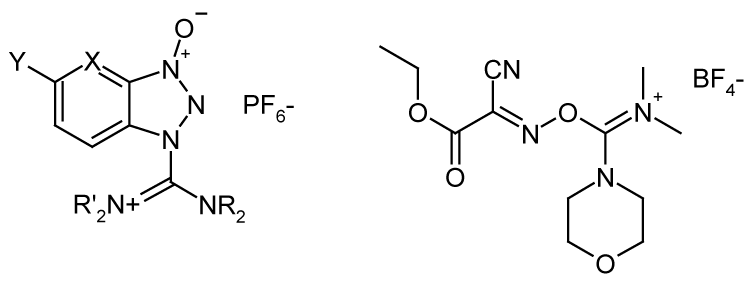 |
|||
| Catalog Ref. # HCK1005-01-004: This kit contains the most common derivatives of HATU and ethyl(hydroxyimino) cyanoacetate as a safe alternative to HOBt. | |||
| Name | CAS Number | Quantity | Amount |
| HATU | 148893-10-1 | 2x vial | 10 μmol |
| HBTU | 94790-37-1 | 2x vial | 10 μmol |
| HCTU | 330645-87-9 | 2x vial | 10 μmol |
| COMU® | 1075198-30-9 | 2x vial | 10 μmol |
| HDMC | 1082951-62-9 | 2x vial | 10 μmol |
| HDMA | 958029-37-3 | 2x vial | 10 μmol |
| ethyl(hydroxyimino)cyanoacetate | 3849-21-6 | 2x vial | 70 μmol |
| COMU is a registered trademark of Luxembourg Bio Technologies Ltd. | |||
|
|||
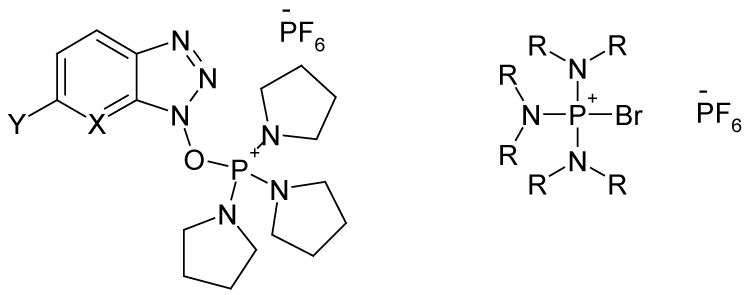 |
|||
| Catalog Ref. # HCK1005-01-006: This kit contains the most common derivatives of PyBOP and ethyl(hydroxyimino)cyanoacetate as a safe alternative to HOBt. | |||
| Name | CAS Number | Quantity | Amount |
| PyBOP® | 128625-52-5 | 2x vial | 10 μmol |
| PyAOP | 156311-83-0 | 2x vial | 10 μmol |
| TPTDP | 893413-42-8 | 2x vial | 10 μmol |
| BroP | 50296-37-2 | 2x vial | 10 μmol |
| PyBrop | 132705-51-2 | 2x vial | 10 μmol |
| DEPBT | 56602-33-6 | 2x vial | 10 μmol |
| ethyl(hydroxyimino)cyanoacetate | 3849-21-6 | 2x vial | 70 μmol |
| PyBOP is a registered trademark of Merck KGaA. | |||
|
|||
| Catalog Ref. # HCK1005-01-007: The first choice array contains a selection of the most representative coupling reagents from the 3 reagent classes; Carboddimide, Aminium and Phosphonium salts. We included ethyl (hydroxyimino)cyanoacetate) as a safe alternative to HOBt. We can also create any custom array that would fit your needs. | |||
| Name | CAS Number | Quantity | Amount |
| DIC | 693-13-0 | 2x vial | 10 μmol |
| EDC, HCl | 25952-53-8 | 2x vial | 10 μmol |
| HATU | 148893-10-1 | 2x vial | 10 μmol |
| COMU® | 1075198-30-9 | 2x vial | 10 μmol |
| PyBOP® | 128625-52-5 | 2x vial | 10 μmol |
| DEPBT | 56602-33-6 | 2x vial | 10 μmol |
| ethyl(hydroxyimino)cyanoacetate* | 3849-21-6 | 2x vial | 70 μmol |
| PyBOP is a registered trademark of Merck KGaA. COMU is a registered trademark of Luxembourg Bio Technologies Ltd. |
|||
Suzuki-Miyaura Coupling Kits |
|||
| Product overview: The Suzuki-Miyaura coupling kits are ideal tools for the investigation of chemical reaction conditions. These kits enable you to conveniently screen multiple reaction simultaneously using pre-weighed catalysts and reagents. The kit contains all reagents to perform the reaction conditions. # HCK1003-01-001: Includes 1 set of reagents and solvents with 6 catalysts & 4 bases # HCK1003-01-002: Includes 1 set of reagents and solvents with 8 catalysts & 4 bases Kit contents: 4 reaction vials of each catalysts, 4 bases in aqueous solution at 1M concentration and 4 solvents. Catalysts available: Pd(PPh3)4, Pd(dppf)2Cl2, PdOAc2/SPhos, PdOAc2/XPhos, Pd2(dba)3/SPhos, Pd2(dba)3/XPhos, PdOAc2/CataCXium® A and Pd(Amphos)Cl2 Bases: 1M aqueous solutions of Na2CO3, K2CO3, K3PO4 and Cs2CO3 Solvents: Dioxane, n-Butanol, DMF and acetonitrile (sparged with Argon). Reaction Conditions |
|||
| Catalysts | ||||||||
| Pd(PPh3)4 | Pd(dppf)2 Cl2 |
PdOAc2 SPhos | PdOAc2 XPhos | Pd2(dba)3 SPhos | Pd2(dba)3 XPhos | PdOAc2 CataCXium®A | Pd(Amphos) Cl2 |
|
| Na2CO3 | Primary array HCK1003-01-001 6 catalysts & 4 bases |
Extended array HCK1003-01-002 8 catalysts & 4 bases |
||||||
| K2CO3 | ||||||||
| K3PO4 | ||||||||
| Cs2CO3 | ||||||||
| cataCXium is a registered trademark of Evonik Degussa GmbH. | ||||||||
Pd Catalyzed Amination Kits
|
|||
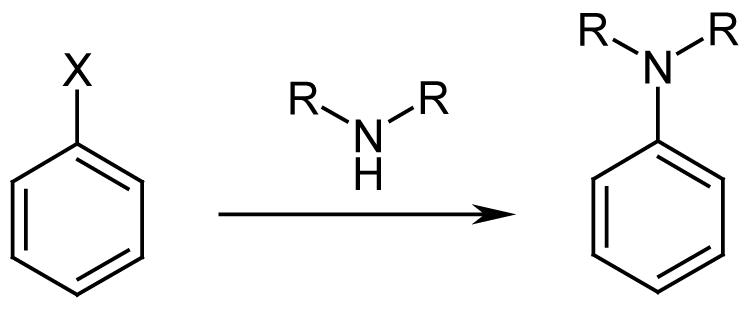 |
|||
| Product overview: The Pd Catalyzed Amination Kits are ideal tools for the investigation of most common precatalysts and bases. These kits enable you to conveniently screen multiple reaction conditions simultaneously using pre-weighed catalysts and reagents. The kit contains all reagents and supplies to perform the reaction conditions. Hepatochem offer pre-selected arrays of precatalysts and salts or custom arrays depending on your needs. Palladium catalyzed amination (Buchwald-Hartwig amination) can be performed using a wide variety of palladium sources, ligands, bases and solvents. Hepatochem designed 2 kits using a combination of palladium precatalysts with either strong bases or weak bases. Key variables
|
|||
|
Weak base arrays
|
||||
| Step 1 Prepare solution of substrates |
Step 2 Transfer in reaction vials containing coupling reagents |
Step 3 Stir the reaction vials in the reaction block at desired temperature |
||
| 3-Step protocol | 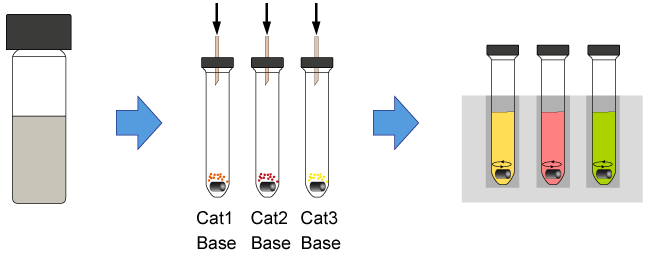 |
|||
| Pd Amination weak bases kits (Includes 2 set of reagents). # HCK1004-01-002: 5 Catalysts and 3 bases combinations premixed in same vial. # HCK1004-01-004: 8 Catalysts and 3 bases combinations premixed in same vial. |
||||
| Substrate 15 μmol |
Weak Bases 30 μmol (2 eq) | ||
| Precatalysts 1.5 µmol (10%) | K2CO3 | Cs2CO3 | K3PO4 |
| BrettPhosG2 | Primary array HCK1004-01-002 5 catalysts & 3 bases |
||
| RuPhosG2 | |||
| XPhosG2 | |||
| tBuXPhosG3 | |||
| tBuBrettG3 | |||
| Pd2dba3/ dppf | Extended array HCK1004-01-004 8 catalysts & 3 bases |
||
| Pd(PtBu3)2 | |||
| Pd(OAc)2/CataCXium® A | |||
| # HCK1004-01-006: 8 Catalysts and 3 bases combinations premixed in same vial. # HCK1004-01-007: 8 Catalysts and 4 bases combinations premixed in same vial. # HCK1004-01-008: 8 Catalysts and 3 bases combinations premixed in same vial. # HCK1004-01-009: 8 Catalysts and 4 bases combinations premixed in same vial. |
| Substrate 15 μmol |
Weak Bases 30 μmol (2 eq) | |||||
| Precatalysts 1.5 µmol (10%) | K2CO3 | Cs2CO3 | K3PO4 | KOAc | ||
| BrettPhosG2 | Primary array HCK1004-01-006 8 catalysts & 3 bases |
Extended array HCK1004-01-007 8 catalysts & 4 bases |
||||
| RuPhosG2 | ||||||
| XPhosG2 | ||||||
| tBuXPhosG3 | ||||||
| tBuBrettG3 | ||||||
| AmphosG3 | ||||||
| AdBrettPhosG3 | ||||||
| CataCXium® A G3 | ||||||
| DavePhosG3 | Primary array HCK1004-01-008 8 catalysts & 3 bases |
Extended array HCK1004-01-009 8 catalysts & 4 bases |
||||
| JackiePhosG3 | ||||||
| JosiphosG3 | ||||||
| P(t-Bu)3G4 | ||||||
| PCy3G4 | ||||||
| RockPhosG3 | ||||||
| SPhosG3 | ||||||
| XantphosG3 | ||||||
Strong base arrays
|
|||||
| No need to handle strong bases. Simple protocol. | Step 1 Prepare solution of substrates |
Step 2 Transfer in vials containing catalyst and mix |
Step 3 Transfer in reaction vials containing base |
Step 4 Stir the reaction vials in the reaction block at desired temperature |
|
 |
|||||
| Pd Amination strong bases kits (Includes 2 set of reagents). # HCK1004-01-003: 5 Catalysts and 2 bases in separated vials. # HCK1004-01-005: 8 Catalysts and 3 bases in separated vials. # HCK1004-01-014: 8 Catalysts and 2 bases in separated vials. |
|||||
| Substrate 15 μmol |
Strong Bases 22.5 μmol (1.5 eq) | ||
| Precatalysts 1.5 µmol (10%) | NaOtBu | LHMDS | P2-Et |
| BrettPhosG2 | Primary array HCK1004-01-003 5 catalysts & 2 bases |
Extended array HCK1004-01-005 8 catalysts & 3 bases |
|
| RuPhosG2 | |||
| XPhosG2 | |||
| tBuXPhosG3 | |||
| tBuBrettG3 | |||
| Pd2dba3/ dppf | Extended array HCK1004-01-014 8 catalysts & 2 bases |
||
| Pd(PtBu3)2 | |||
| Pd(OAc)2/CataCXium® A | |||
| # HCK1004-01-010: 8 Catalysts and 2 bases combinations premixed in same vial. # HCK1004-01-011: 8 Catalysts and 3 bases combinations premixed in same vial. # HCK1004-01-012: 8 Catalysts and 2 bases combinations premixed in same vial. # HCK1004-01-013: 8 Catalysts and 3 bases combinations premixed in same vial. |
| Substrate 15 μmol |
Strong Bases 22.5 μmol (1.5 eq) | ||||
| Precatalysts 1.5 µmol (10%) | NaOtBu | LHMDS | P2-Et | ||
| BrettPhosG2 | Primary array HCK1004-01-010 8 catalysts & 2 bases |
Extended array HCK1004-01-011 8 catalysts & 3 bases |
|||
| RuPhosG2 | |||||
| XPhosG2 | |||||
| tBuXPhosG3 | |||||
| tBuBrettG3 | |||||
| AmphosG3 | |||||
| AdBrettPhosG3 | |||||
| CataCXium® A G3 | |||||
| DavePhosG3 | Primary array HCK1004-01-012 8 catalysts & 2 bases |
Extended array HCK1004-01-013 8 catalysts & 3 bases |
|||
| JackiePhosG3 | |||||
| JosiphosG3 | |||||
| P(t-Bu)3G4 | |||||
| PCy3G4 | |||||
| RockPhosG3 | |||||
| SPhosG3 | |||||
| XantphosG3 | |||||
Weak & strong base array |
|||||
| Pd Amination weak & strong bases kits (Includes 2 set of reagents). # HCK1004-01-015: 8 Catalysts and Cs2CO3 combinations premixed in same vial and 8 Catalysts and NaOtBu in separated vials |
| Substrate 15 μmol |
Strong Bases 22.5 μmol (1.5 eq) |
Weak Bases 30 μmol (2 eq) |
| Precatalysts 1.5 µmol (10%) | NaOtBu | Cs2CO3 |
| BrettPhosG2 | Array HCK1004-01-015 8 catalysts & 2 bases |
|
| RuPhosG2 | ||
| XPhosG2 | ||
| tBuXPhosG3 | ||
| tBuBrettG3 | ||
| Pd2dba3/ dppf | ||
| Pd(PtBu3)2 | ||
| Pd(OAc)2/CataCXium® A | ||
Ullmann Reaction Kit |
|||
| Product overview: The Ullmann reaction is a interesting alternative to palladium based cross-coupling chemistry. These reaction conditions work with amide, aromatic amine or indole. The Ullmann reaction kit enables to conveniently screen multiple ligands and bases simultaneously using pre-weighed catalysts and reagents. |
|||
| # HCK1011-01-001. Kit contents: 2 reaction vials of each catalyst system and base, 36 reaction vials total | |||
| Copper Iodide / Ligand | ||||||
| No Ligand | Phenanthroline | S-Proline | 1,2-cyclohexane diamine | N,N´-Dimethyl ethylene diamine |
Isobutyryl cyclohexanone |
|
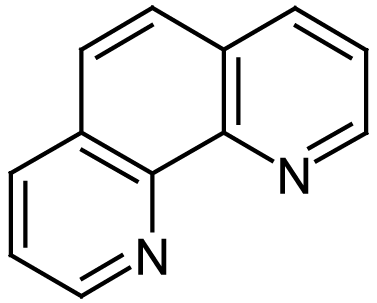 |
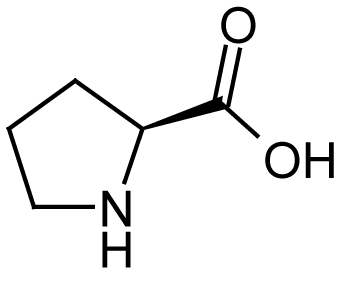 |
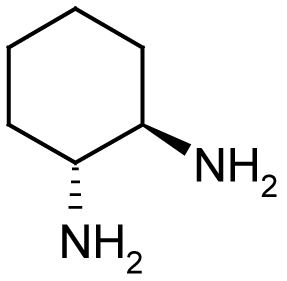 |
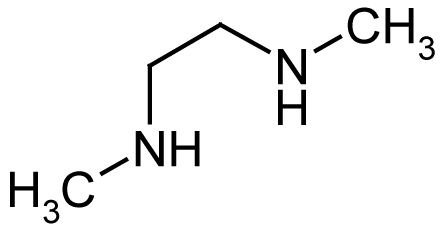 |
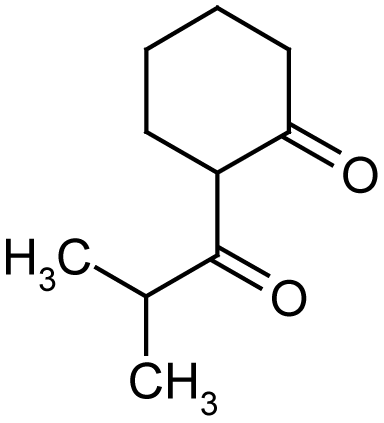 |
||
| Cs2CO3 |
array HCK1011-01-001 6 catalyst systems & 3 bases |
|||||
| K2CO3 |
||||||
| K2PO4 | ||||||
Diversity Kit: 4 different functionalizations |
|||
| C-H Alkoxylation is one of the most common C-H functionalization described in literature. The kit is designed to conveniently screen both alkoxylation & acetoxylation reaction conditions using PdOAc2 as catalyst and several oxidants and additives. | |||
| Kit # HCK1007-01-001: Includes 2 set of reagents; Catalyst and oxidant are mixed in same vial. Substrate solution is prepared in DMF as one common stock and added to all 4 for solvents. Screen four solvents with three reaction conditions. 10 mol% Pd(OAc)2, 1 equiv. PhI(OAc)2. |
|||
| Transformation | ... | CuOAc2 | Ag2CO3 |
| H -> OMe | 10 mol% PdOAc2 1 equiv. PhIOAc2 |
||
| H -> OEt | |||
| H -> OiPr | |||
| H -> OAc | |||
Salt Effect on C-H functionalization: Optimization Kit: 5 different salts |
|||
| It has been reported that salt can improve and promote C-H functionalization. The kit is designed to facilitate the screen of multiple salts simultaneously. These kits contains 5 different salts CuOAc2, Ag2CO3, K2CO3, Cs2CO3 and MgSO4 | |||
| Kit # HCK1007-01-002: Screen 1 solvent with 12 reaction conditions. 10 mol% PdOAc2, 1 or 2 equivalents of PhIOAc2 with 5 different salts. Prepare one solution in solvent or mixture in DMF if solubility issues. | |||
| Array with 12 reaction conditions | ||||||
| ... | CuOAc2 | Ag2CO3 | K2CO3 | Cs2CO3 | MgSO4 | |
| 10% Pd(OAc)2 | 1 equiv. PhI(OAc)2 | |||||
| 10 % Pd(OAc)2 | 2 equiv. PhI(OAc)2 | |||||
Metabolite Production Made Easy
|
|||
| Product overview: HepatoChem has developed a revolutionary way to screen, optimize, and produce metabolites directly from drug candidates. The BMO Kit exploits an optimized panel of catalytic chemical reaction conditions using or-ganometallic catalysts in a multi-well parallel format. This tool mimics the suite of cytochrome P450 enzymes (CYP) present in human hepatocytes, offering the researcher a unique synthetic chemical liver. The BMO kits enable, in three simple steps,
|
| Screen | Optimize | Produce |
 |
||
| 1) Perform the primary screen. Select desired metabolite wells. |
2) Perform the optimization kit. Identify best production conditions. |
3) Scale-up and isolate your metabolite. |
Available Biomimetic Oxidation Kits
|
||
| BMO Screening Kit |
# HCK1001-01-001 |
|
Perform the primary screen. Select desired metabolite wells. Order corresponding optimization kit. Complete kit includes all solvents and reagents for 2x25 screening reaction conditions. 2 plates included. |
||
| BMO Optimization Kit | # HCK1001-02-xxx |
|
Perform the optimization kit. Identify best production conditions. Order corresponding production kit. Complete kit includes all solvents and reagents for optimization of selected screening reaction conditions. 1 plate included. |
||
| BMO Production Kit | # HCK1001-03-xxx-10 |
|
Scale-up and produce your metabolite. Complete kit includes all solvents and reagents for your metabolite at 12.5 μmol scale or more. |
||
Metabolite Production Made Easy
|
|||
| Product overview: HepatoChem has developed a revolutionary way to screen, optimize, and produce metabolites directly from drug candidates. The glucuronidation kit exploits an optimized panel of chemical reaction conditions using coupling reagents in a multi-well parallel format. This kit suite is designed to survey chemical reaction conditions that produce O glucuronides. The reaction conditions are derivative of the Koenigs-Knorr reaction. This is a 2 step process:
|
| 1) Coupling with glucuronidation reagent | ||
 |
||
2) De-protection with base solution |
||
 |
||
| This kit is using 4 different salts (Ag2CO3, Ag2O, Cs2CO3 and Na2CO3) with 2 different solvents (CH3CN and CHCl3), 8 reaction conditions as well as 2 reaction conditions using BF3. The first step is performed at 25°C overnight except for BF3 conditions which are performed at 0°C. Because the reactivity of the substrate may vary, different reaction temperatures or reaction time may be explored. Also we encourage the user to analyze the reaction mixture after the first step, in order to identify the reaction conditions that form the most protected glucuronide product. The second step consists of de-protecting the intermediate using NaOH/MeOH solution or LiOH/MeOH solution. The optimum quantity needed for the protection may vary due to the functional groups present on the substrate as well as the stability of the final product. |
Available Glucuronidation Kits |
||
| Glucuronidation refill kit | # HCK1002-01-001 |
|
Glucuronidation array kit (10 reaction conditions) to generate O glucuronide metabolite. This kit includes 2 refill of reagents. |
||
| Glucuronidation optimization kit | # HCK1002-02-XXX |
|
Optimization array kit (4 reaction conditions) to optimize O glucuronide metabolite production. This kit includes 4 refill of reagents. |
||
| Glucuronidation production kit | # HCK1002-03-XXX |
|
Production kit to generate O glucuronide metabolite at 12.5 μmol scale. This kit includes 4 refill of reagents. |
||
Product overview
|
| The sulfinate alkylation reaction described by Prof. Baran is a powerful late stage functionalization tool. Hepatochem kit allows to conveniently produce in one step 6 different analogues of a lead compound in mg quantities. Each reaction vial contains 100 µmol of sulfinate alkylation reagent (pre-weighed) and a stirring bar to react with 50 µmol of substrate. C-H functionalization will primarily occur on electron-deficient heteroarenes at one or several positions. |
6 Different Diversification Groups
|
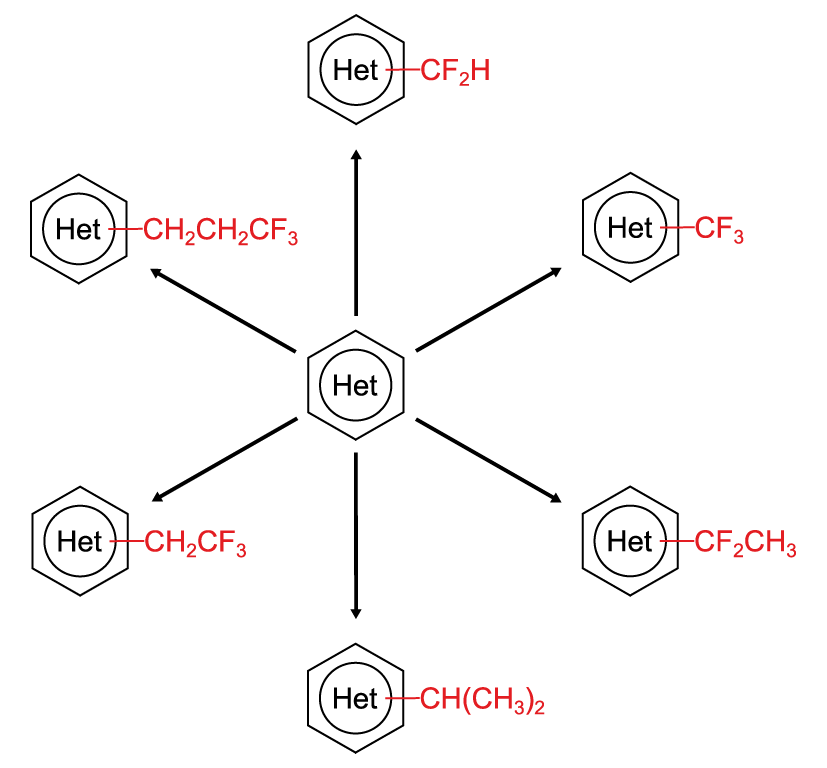 |
| Kit contents HCK1013-01-001: 2 reaction vials of each reagents (100 µmol), 12 reaction vials total |
Sulfinate Alkylation Reagents (2 Vials of each)
|
| Zinc difluoro methane sulfinate | Zinc trifluoro methane sulfinate | Sodium 1,1-difluoro ethane sulfinate |
Zinc trifluoro ethane sulfinate |
Zinc isopropyl sulfinate |
Sodium trifluoro propyl sulfinate |
|||||||
| MW (g/mol) | 295.55 | 331.53 | 152.10 | 359.58 | 279.69 | 184.11 | ||||||
| CAS Number | 1355729-38-2 | 39971-65-8 | 1422738-67-7 | 1416821-53-8 | 1416821-55-0 | 1263377-91-8 |
| HepatoChem kit is now available in 2 sizes : A small scale kit to screen the chemistry using multiple solvents (HCK1013-01-002) and a production kit (HCK1013-01-001) described above. |
| Literature references: Ming Yan, Julian C. Lo, Jacob T. Edwards, and Phil S. Baran J. Am. Chem. Soc., 2016, 138 (39), pp 12692–12714 Fionn O’Hara, Donna G. Blackmond*, and Phil S. Baran J. Am. Chem. Soc., 2013, 135 (32), pp 12122–12134 |
| Product overview: HCK1008-01-001 Fluorination is one of the most interesting C-H functionalization described in literature. Our kit is designed to conveniently screen fluorination reaction conditions using PdOAc2 as catalyst in presence of most common fluorine sources; Silver Fluoride AgF, 1-fluoro-2,4,6-trimethyl-pyridinium triflate (TMPyF), SelectFluor®, and N-fluorobenzenesulfonimide (NFSI) and oxidant Bis(tert-butylcarbonyloxy iodobenzene (PhIOPiv). |
12 conditions with AgF, TMPyF, Selectfluor and NFSI |
||
| Kit HCK1008-01-001: Includes 2 sets of reagents; Catalyst and oxidant are mixed in the same vial. |
||
EvoluChem supplies |
||
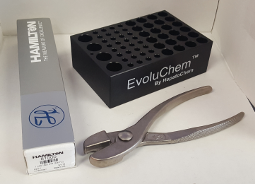 |
Starter Kit 1 reaction block (24x 2ml vial, 32X 0.3ml vial, 4X 2Dram vial), 1 decapper for 8 mm crimped vial and 1 syringe Hamilton 81000. HCK1006-01-001 |
|
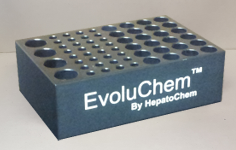 |
EvoluChem Block fits 3 types of vials 1 reaction block (24x 2ml vial, 32x 0.3ml vial, 4x 2Dram vial) HCK1006-01-002 |
|
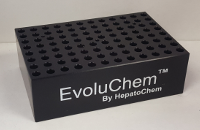 |
EvoluChem Block fits 96x 0.3ml vials 1 reaction block (96x 0.3ml vial) HCK1006-01-003 |
|
 |
Micro stir bar 2 x 2 mm 50 stir bars HCK1006-01-012 |
|
 |
Micro stir bar 2 x 7 mm 50 stir bars HCK1006-01-015 |
|
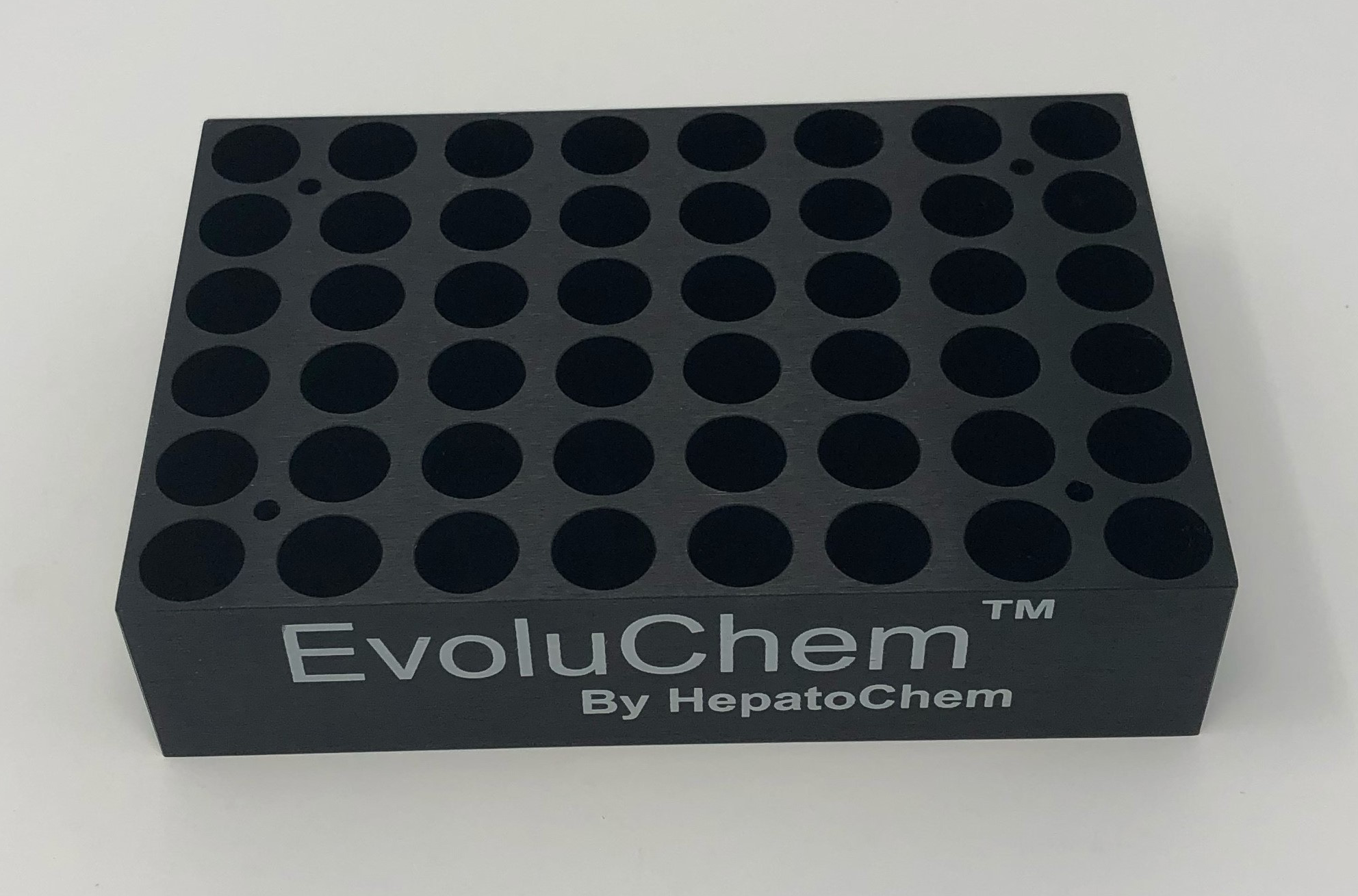 |
Reaction block 48 x 2 ml vials 1 Reaction block 48 x 2 ml vials HCK1006-01-032 |
|
